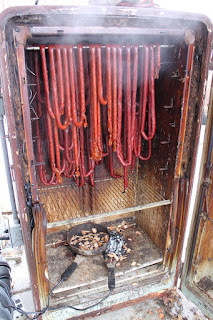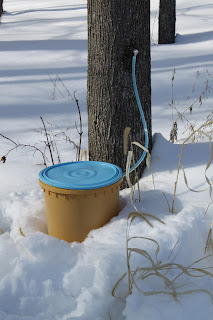It has been said for decades “you don’t really want to know how the sausage is made.” Well, here’s your opportunity to find out how our venison sausage is made, with nary a stomach-churning description to be found. Unless you’re vegetarian, of course. But if you are, we probably lost you at the title of the post, didn’t we? For those still with us, read on for a peek behind the curtain (or into the grinder).
The secret to venison sausage is… pork. Yes, pork. True, venison alone would make a nice low-fat sausage, but it would also be a dry, tasteless sausage. Sausages need fat for flavor and juiciness, but what little fat venison has just tastes nasty. Really gross. So before we grind our venison for the sausage, we trim all the fat off. Enter the pork. Most venison sausage recipes call for a mix of venison, pork fat, and pork lean, with the pork fat & lean at a 1:1 ratio. We trade off a little of the flavor and juiciness for a lower-fat sausage, so we buy pork butt roasts that are probably closer to 75% lean. We grind the meats separately, then plop them into a giant plastic tub, 25 pounds of meat at time. Next, the spices, which get mixed with water into a spicy slurry, so that they mix more evenly with the meat.
For our favorite wild rice bratwurst, we soften up 16 oz. of wild rice by pouring boiling water over it, let it cool, pour off the water, and repeat the process two more times. After the meat, spices, and wild rice are well-mixed by hand, we load the mixture into a sausage stuffer, where we pump it into natural casings made from beef intestines. (Ok, we lied. That may have grossed some of you out…sorry! We promise, that’s the last time.) We twist the casings every six inches to form the individual sausages, creating a long, somewhat festive meat garland to adorn our freezer for the coming months (in tidy vacuum-sealed packages of four).
 We use manufactured collagen casings for our smoked snack sticks (think Slim Jims, only larger in diameter, with a fraction of the ingredients, and way, way, way tastier), for which we use 60% venison, 40% pork, and a different spice blend. Since these sausages are eaten cold or room temperature, we have to add cure (sodium nitrite) to inhibit the growth of microorganisms, particularly the ones that cause botulism. Cure is also what gives sausages their trademark pink/red color and adds some distinctive flavor. After stuffing the casings, we load them into our refrigerator smoker. Yes, you read that right. Our smoker is made out of 1940’s refrigerator. More on that in an upcoming post. We smoke the sausages at 125 degrees for five hours, then at 170 until they’re fully cooked with an internal temperature of 156 degrees, then cool and freeze them.
We use manufactured collagen casings for our smoked snack sticks (think Slim Jims, only larger in diameter, with a fraction of the ingredients, and way, way, way tastier), for which we use 60% venison, 40% pork, and a different spice blend. Since these sausages are eaten cold or room temperature, we have to add cure (sodium nitrite) to inhibit the growth of microorganisms, particularly the ones that cause botulism. Cure is also what gives sausages their trademark pink/red color and adds some distinctive flavor. After stuffing the casings, we load them into our refrigerator smoker. Yes, you read that right. Our smoker is made out of 1940’s refrigerator. More on that in an upcoming post. We smoke the sausages at 125 degrees for five hours, then at 170 until they’re fully cooked with an internal temperature of 156 degrees, then cool and freeze them.
This year we tried making hotdogs for the first time! We made them the same way we made the snack sticks (but with larger-diameter casings and yet another spice blend), but smoked them for only an hour and a half at 125 degrees before raising the temperature. After they reached the requisite 156 degrees, we gave them the full Minnesota treatment – we pulled them from their sauna and threw them into a refreshing ice bath to cool them down quickly and preserve some of the  internal moisture. Since the collagen casings are kind of chewy compared to the texture of the wieners, we peeled them off before freezing them. The final tally: 100 wild rice bratwurst, 25lbs of chipotle snack sticks, 13 pounds of hot dogs, and a fully-stocked freezer full of savory sausage to go with our cellar full of sauerkraut!
internal moisture. Since the collagen casings are kind of chewy compared to the texture of the wieners, we peeled them off before freezing them. The final tally: 100 wild rice bratwurst, 25lbs of chipotle snack sticks, 13 pounds of hot dogs, and a fully-stocked freezer full of savory sausage to go with our cellar full of sauerkraut!
 This past weekend, the Kopp family took in the joys of the Isanti County Fair. First stop: the open class displays, where county residents show off the products of their crafting, baking, artistry and gardening. Friends of ours took first place on some photography and vegetable categories - congratulations to Bridget & Dave!
This past weekend, the Kopp family took in the joys of the Isanti County Fair. First stop: the open class displays, where county residents show off the products of their crafting, baking, artistry and gardening. Friends of ours took first place on some photography and vegetable categories - congratulations to Bridget & Dave! 






















